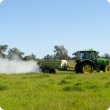Services
Search in Services
Filter services by topic
- (-) Remove Climate change filter Climate change
- Climate, land & water (7) Apply Climate, land & water filter
- Climate & weather (7) Apply Climate & weather filter
- Livestock & animals (5) Apply Livestock & animals filter
- Soils (3) Apply Soils filter
- Measuring and assessing soils (3) Apply Measuring and assessing soils filter
- Grains (3) Apply Grains filter
- Crops (3) Apply Crops filter
- Production & postharvest (1) Apply Production & postharvest filter
- Managing soils (1) Apply Managing soils filter
- Soil carbon (1) Apply Soil carbon filter
- Soil management (1) Apply Soil management filter
- Livestock research & development (1) Apply Livestock research & development filter
- Wheat (1) Apply Wheat filter
- Feeding & nutrition (1) Apply Feeding & nutrition filter
- Carbon farming (1) Apply Carbon farming filter
- Genetics & selection (1) Apply Genetics & selection filter
- Grains Research & Development (1) Apply Grains Research & Development filter
- Liming (1) Apply Liming filter
- Livestock management (1) Apply Livestock management filter



